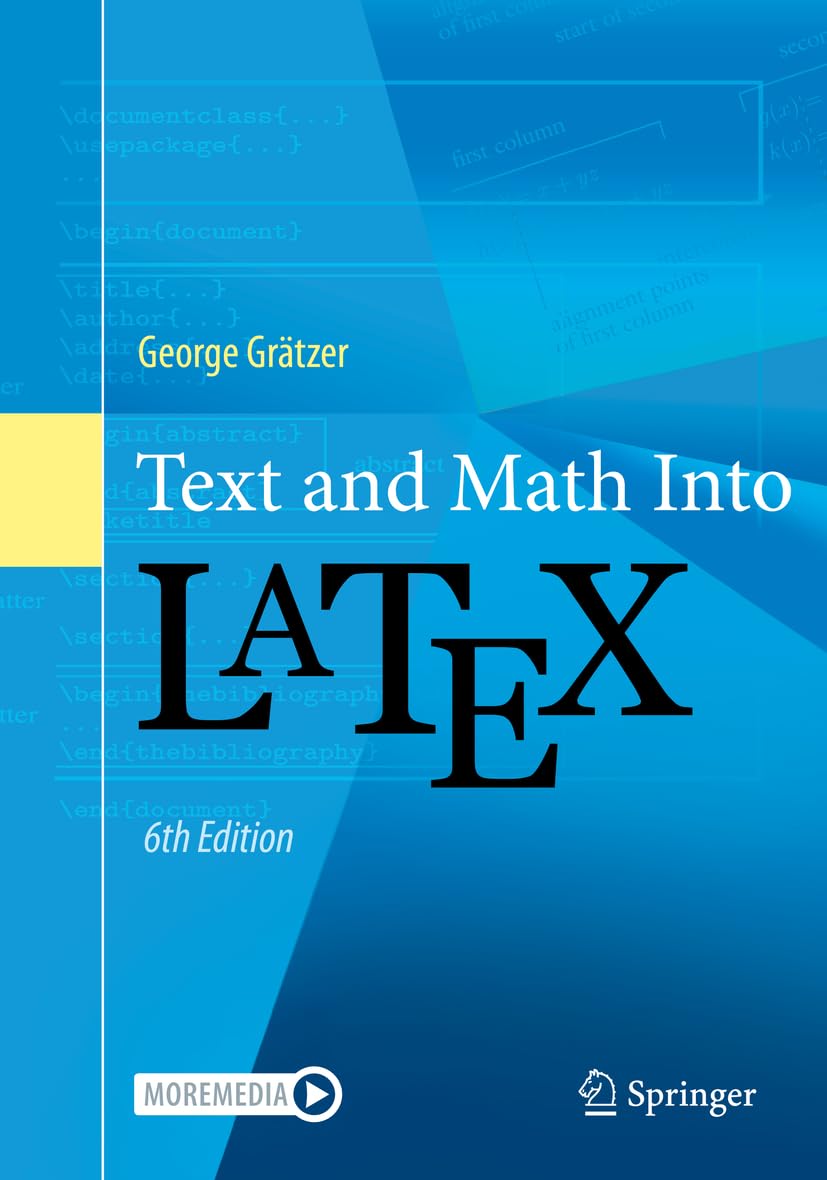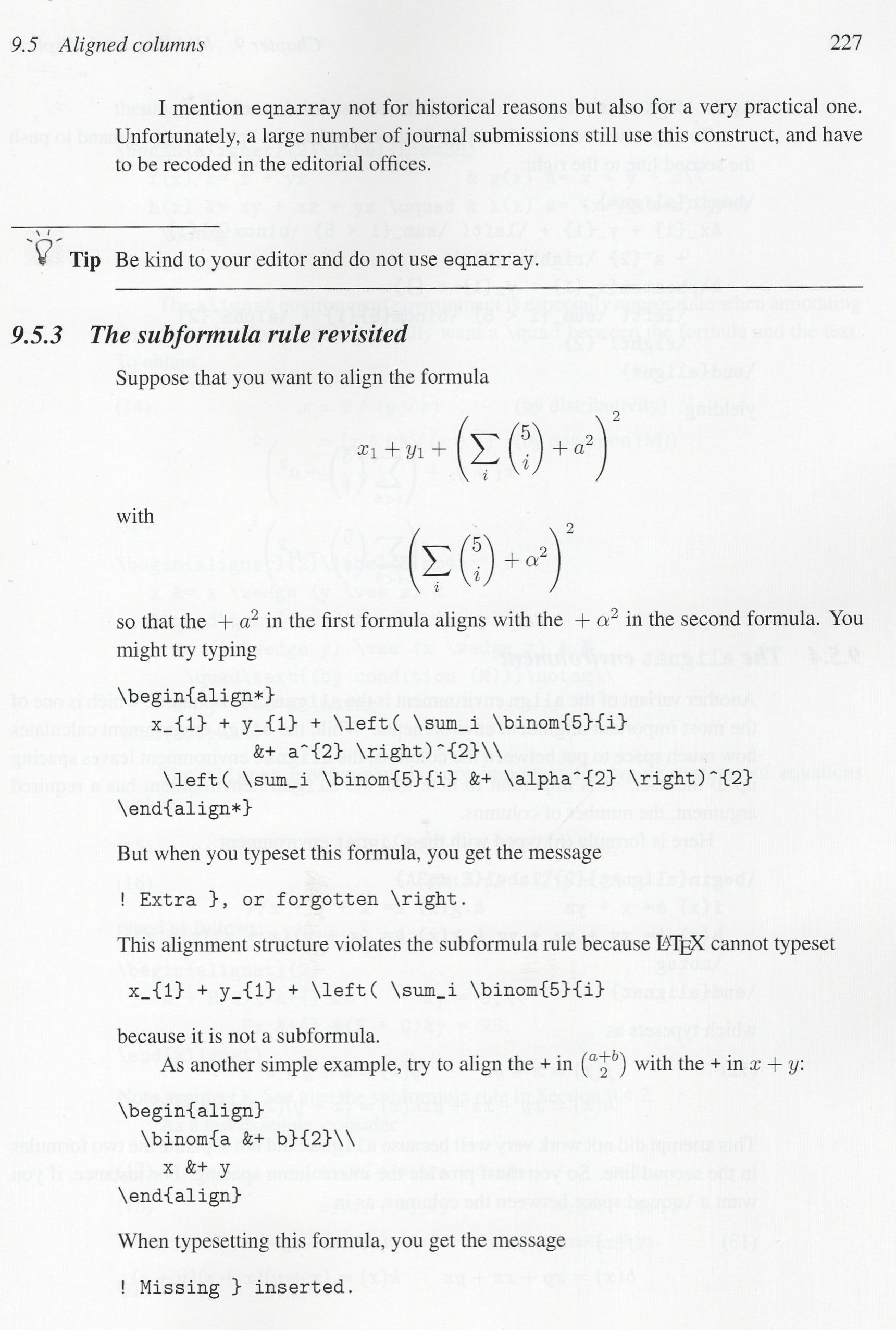
George Grätzer, Text and Math Into LaTeX,
April 2024, 645pp., ISBN 3031552806.
https://link.springer.com/book/10.1007/978-3-031-55281-6
Text and Math Into LaTeX, 6th edition by George Grätzer is the latest version of a well-known book. Reviewing the prior edition for TUGboat was a pleasure so I was happy to also look at this one with the slightly changed title. It is a good update.
The audience is people who write mathematics, including mathematicians, physicists, and computer scientists. The presentation is of consistently high quality: thorough and clear.
As to approach, think of it as a desk reference. The prior edition sits on my desk along with five or six other books that I reach for at least once a week. It reminds me of my options in aligning equations, of how to do a ‘see also’ in MakeIndex, which of \makebox’s optional arguments comes first, and so forth.
It covers, or at least provides a pointer to, the great majority of what an author would need in order to prepare a journal article, a book, or a presentation. And it avoids the error of trying to do everything.
Many people look for their LaTeX answers on Stack Exchange1 or other such sites. These are awesome resources.
However, many LaTeX users lack the vocabulary or mental models to effectively search for an answer or to formulate their own question. I sympathize, since I often find it hard myself. It is a big help to having the material organized so that ideas that are close conceptually are also nearby physically.
Another problem with the Internet is that it is getting old. There is a lot out there that is either outdated or else just wrong. One example is the many pages describing how to switch to entering input in UTF-8, which is now the default. Having a book with updated information is an improvement.
In approaching this material, there is a tension between being an introduction and being a reference. Mostly Professor Grätzer sticks to being a reference, although there is a brief (about fifty pages) Short course. That fits the needs of people who use the tools but are not expert.
The great majority of the book is suitable for dipping into when you have a specific problem. It does not attempt to tell you how to use a text editor, or to explain a whatsit. But a reader who needs a reminder of how to make matrices and matrix variants, along with practical tips, will find that here.
The book is absolutely full of working code. I’ll bet that everyone reading this review has found that what helps users see what to do is not syntax diagrams, but code that they can enter.
The book is also full of error messages. When I hear people grouse about LaTeX, always mentioned is puzzling over what a particular output message might mean, and what needs to be changed in the input as a fix. This book is very good at making connections. Not long ago I had a student ask me why Double subscript is an error, when it is after all what they were trying to do. Grätzer includes the message along with a contrast between $a^{b}^{c}$ and $a^{b^{c}}$.
In general, as I mentioned in the prior review, one of the book’s strengths is a good sense for what it is that causes users to struggle. The Tips particularly shine. Many of them are spot-on for where in my experience people ask about how to accomplish something. This is evident in the Tip in the sample page below.

Text and Math Into LaTeX has seven Parts, and seven appendices. First is the short course. Second is Text into LaTeX, which is new in this edition and which I will discuss below. Part III is Fonts for text and math.
Next is the key Part, Math into LaTeX. On my copy of the prior edition this is where the page edges are dirty. It covers many things such as delimiters, symbols, and displayed equations including multiline equations.
Part V is Document structure, which discusses the American Mathematical Society article class. In Part VI, there are chapters on hyperlinks, Beamer, and TikZ (which I will discuss more below). Part VII covers custom commands, including list commands. Finally, Part VIII is Long documents and addresses BibTeX, BibLaTeX, and Makeindex.
The appendices have tables for the common math symbols and text symbols, as well as an appendix introducing ChatGPT.
I also noted that very early in the book (page five) is a mention of the TeX Users Group website (tug.org). That’s great to see, of course.
In this edition, broken out as a separate part, is Text into LaTeX. It covers eighty pages of things such as paragraphs, making spaces, and making tables. Since one of the strengths of the book is the way that it organizes the material for ease of finding things, I consider this move a good one.
The material on TikZ has been updated and improved. For drawing I instead use Asymptote, so I cannot judge the selection of material here but I’ll say that on the forum I go to most often, which is full of beginners, perhaps a quarter of the questions are on this topic. It needs solid coverage. I see that Professor Grätzer thanks Michael Doob for his work on that chapter, so it is good to see that this expanded material has an excellent pedigree.
In the book’s final appendix, Professor Grätzer has included an introduction to ChatGPT. Many people use this tool to write LaTeX or TikZ. A reservation that I have about it is that any introduction will soon be obsolete. However, it is only a few pages and some readers may find it interesting.
For coverage of most packages, this book defers to the LaTeX Companion [1]. That makes perfect sense, although there are some additional packages where perhaps a two or three sentence description and a suggestion to look up more information might be a help. (I’ll mention as examples fancyhdr2and another, perhaps less obvious, tabularray.)3
This is an excellent desk reference, covering a great deal of LaTeX. It is an ideal choice for a school or department library, or as a gift for a working professional or for a graduate student just starting out.
[1] F. Mittelbach, U. Fischer. The LaTeX Companion: Parts I & II. Addison Wesley, third ed., 2024. https://tug.org/l/tlc3